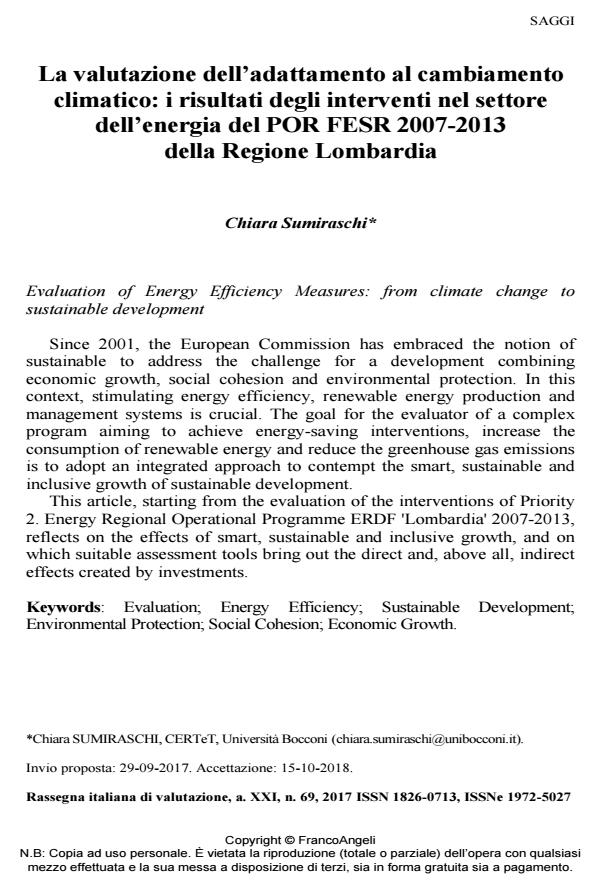Evaluation of Energy Efficiency Measures: from climate change to sustainable development
Journal title RIV Rassegna Italiana di Valutazione
Author/s Chiara Sumiraschi
Publishing Year 2019 Issue 2017/69
Language Italian Pages 25 P. 94-118 File size 689 KB
DOI 10.3280/RIV2017-069006
DOI is like a bar code for intellectual property: to have more infomation
click here
Below, you can see the article first page
If you want to buy this article in PDF format, you can do it, following the instructions to buy download credits

FrancoAngeli is member of Publishers International Linking Association, Inc (PILA), a not-for-profit association which run the CrossRef service enabling links to and from online scholarly content.
Since 2001, the European Commission has embraced the notion of sustainable to address the challenge for a development combining economic growth, social cohesion and environmental protection. In this context, stimulating energy efficiency, renewable energy production and management systems is crucial. The goal for the evaluator of a complex program aiming to achieve energy-saving interventions, increase the consumption of renewable energy and reduce the greenhouse gas emissions is to adopt an integrated approach to contempt the smart, sustainable and inclusive growth of sustainable development. This article, starting from the evaluation of the interventions of Priority 2. Energy Regional Operational Programme ERDF 'Lombardia' 2007-2013, reflects on the effects of smart, sustainable and inclusive growth, and on which suitable assessment tools bring out the direct and, above all, indirect effects created by investments.
Keywords: Evaluation; Energy Efficiency; Sustainable Development; Environmental Protection; Social Cohesion; Economic Growth.
- Le Iniziative Regionali Per Favorire LLInnovazione Nelle Imprese (Regional Policies to Foster Firmss Innovation Activity) Francesca Lotti, Maria Lucia Stefani, Luciana Aimone Gigio, Elena Gennari, Danilo Liberati, Maurizio Lozzi, Marco Marinucci, Roberto Rassu, Monica Amici, Marta Auricchio, Francesco David, Petra Degasperi, Pietro de Matteis, Sabrina Lucia Di Addario, Antonino Figuccio, Michele Loberto, Claudio Salvatore Loreto, Stefania Mariotti, Daniela Mele, Francesca Modena, Pasqualino Montanaro, Eugenia Panicara, Paolo Piselli, Simone Santori, Sonia Soncin, in SSRN Electronic Journal /2014
DOI: 10.2139/ssrn.2584909
Chiara Sumiraschi, La valutazione dell’adattamento al cambiamento climatico: i risultati degli interventi nel settore dell’energia del POR FESR 2007-2013 della Regione Lombardia in "RIV Rassegna Italiana di Valutazione" 69/2017, pp 94-118, DOI: 10.3280/RIV2017-069006